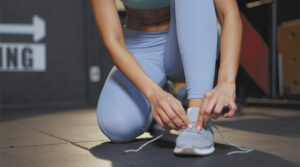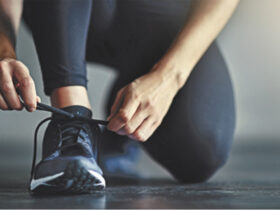By Patrick Bartholomew Jr., DPM, AACFAS
 As a podiatrist, I frequently see patients experiencing foot and lower limb pain from improper footwear or neglecting stretching before and after running. Whether you’re new to running or a seasoned athlete, caring for your feet and muscles is crucial to prevent injury and ensure long-term performance. In this article, I’ll explain why choosing the right sneakers and establishing a suitable pre- and post-workout stretching routine are essential for your running health.
As a podiatrist, I frequently see patients experiencing foot and lower limb pain from improper footwear or neglecting stretching before and after running. Whether you’re new to running or a seasoned athlete, caring for your feet and muscles is crucial to prevent injury and ensure long-term performance. In this article, I’ll explain why choosing the right sneakers and establishing a suitable pre- and post-workout stretching routine are essential for your running health.
The Importance of Supportive Sneakers for Runners
Supportive sneakers are fundamental for maintaining a healthy running routine. Beyond aesthetics and brand popularity, the functionality of your footwear significantly impacts your running experience. Here’s why:
Foot Arch Support: Your feet vary in arch type—flat, high, or neutral—each requiring specific support. Wearing shoes that match your foot’s structure prevents discomfort and injury. For instance, motion-control shoes benefit flat-footed runners by preventing overpronation, while high-arched runners need cushioned stability shoes.
Shock Absorption: Running generates substantial foot pressure. Quality running shoes absorb shock, reducing strain on joints and lowering injury risks like shin splints and plantar fasciitis. Inadequate cushioning forces your feet and legs to absorb excess shock, leading to wear and tear over time.
Proper Fit: Ill-fitting shoes cause blisters, calluses, and chronic pain. Ideal shoes offer ample toe box space, snug heel fit, and arch support. Regular foot measurements are essential, especially for frequent runners whose feet may change shape or size.
Durability and Stability: Durable, stable shoes maintain foot and ankle alignment, reducing sprain and strain risks. Investing in quality shoes designed for running longevity protects your feet and enhances performance.
Pre-Workout Stretching: Why It’s Crucial for Runners
Stretching before running is crucial for preparing your body for the physical demands of exercise. It helps enhance flexibility, improves blood circulation, and activates the muscles you’ll use during your run. A simple stretching routine can include the following exercises:
Dynamic Stretching: These stretches involve movement to activate muscles, tendons, and ligaments crucial for running. Examples include leg swings, lunges with twists, and high knees, improving range of motion and injury prevention.
Focus on the Lower Body: Target calves, hamstrings, quads, and hip flexors to optimize performance and prevent tightness during and after running.
Post-Workout Stretching: A Key Component to Recovery
After running, it’s important to focus on flexibility and recovery to help your muscles relax and prevent tightness. This approach not only alleviates muscle tension but also enhances your stride efficiency, allowing for smoother and more effective movement in future runs.
Pre-Workout Stretching: Why It’s Crucial for Runners
Stretching before running is crucial for preparing your body for the physical demands of exercise. It helps enhance flexibility, improves blood circulation, and activates the muscles you’ll use during your run. A simple stretching routine can include the following exercises:
Dynamic Stretching: These stretches involve movement to activate muscles, tendons, and ligaments crucial for running. Examples include leg swings, lunges with twists, and high knees, improving range of motion and injury prevention.
Focus on the Lower Body: Target calves, hamstrings, quads, and hip flexors to optimize performance and prevent tightness during and after running.
Post-Workout Stretching: A Key Component to Recovery
After running, it’s important to focus on flexibility and recovery to help your muscles relax and prevent tightness. This approach not only alleviates muscle tension but also enhances your stride efficiency, allowing for smoother and more effective movement in future runs.
Static Stretching: Hold stretches for 15-30 seconds to reach deep muscle tissues. Effective stretches include calf stretches, hamstring stretches, and hip flexor stretches, promoting flexibility and reducing stiffness.
Running offers fitness benefits but strains the feet and muscles. Proper sneakers and a consistent stretching routine are vital for performance and long-term health. As a podiatrist, I emphasize foot care and flexibility to prevent injuries and enjoy running for years. For personalized advice on footwear or stretching, schedule a consultation to prioritize your foot health and running enjoyment. Happy running!
Patrick Bartholomew Jr., DPM, AACFAS
Dr. Bartholomew works at Family Foot & Leg Center at the Cape Coral office. He is accepting new patients.
To make an appointment, call 239-430-3668 or visit www.NaplesPodiatrist.com.
530 SE 16th Place, Suite A
Cape Coral, FL 33990
(Across from Cape Coral Hospital)
(239) 430 – 3668 (FOOT)
www.NaplesPodiatrist.com









